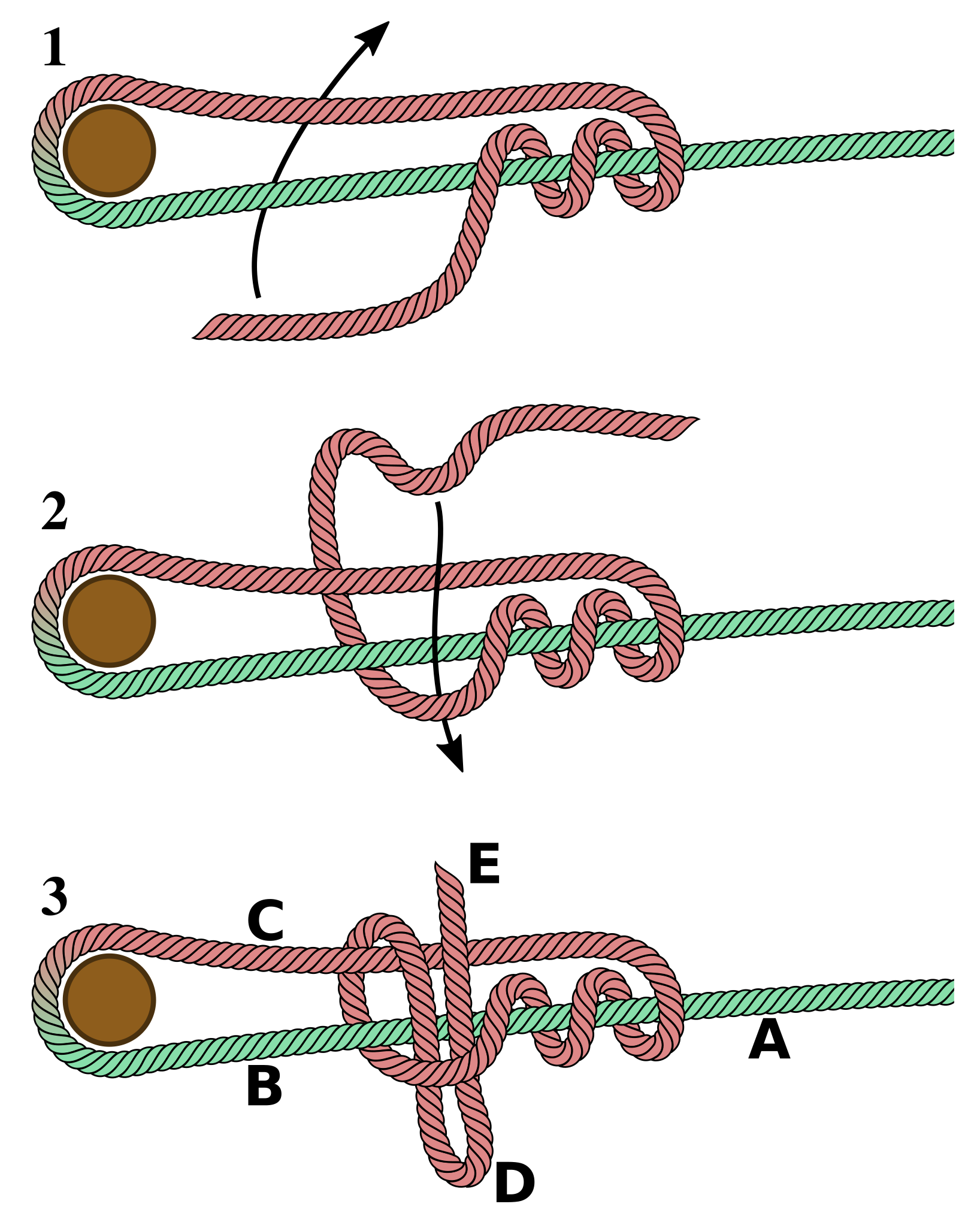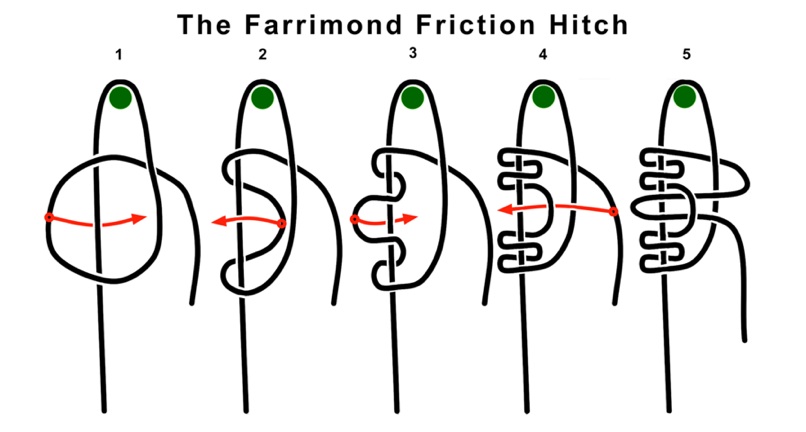|
Adjustable Grip Hitch
The adjustable grip hitch is a simple and useful friction hitch which may easily be shifted up and down the rope while slack. It will hold fast when loaded, but slip when shock loaded until tension is relieved enough for it to again hold fast. It serves the same purpose as the taut-line hitch, e.g. tensioning a tent's guy line. This knot is also called the adjustable loop and Cawley adjustable hitch. It was conceived 1982 by Canadian climber Robert Chisnall. Tying The working end is wrapped inwards around the standing part (A-B) twice (1). Then another turn is made around both parts and a bight is pulled through the last wrap (2, 3) for the slipped version (left image), or just the end for the non-slipped version (right image). The knot needs to be pulled tight to actually grip (the slack is pulled out of the windings and the knot pulled tight at C and D). By pushing the knot along the standing part in direction of A, the line can be tightened. The grip can be improved by addin ... [...More Info...] [...Related Items...] OR: [Wikipedia] [Google] [Baidu] |
Taut-line Hitch
The taut-line hitch is an adjustable loop knot for use on lines under tension. It is useful when the length of a line will need to be periodically adjusted in order to maintain tension. It is made by tying a rolling hitch around the standing part after passing around an anchor object. Tension is maintained by sliding the hitch to adjust the size of the loop, thus changing the effective length of the standing part without retying the knot. It is typically used for securing tent lines in outdoor activities involving camping, by arborists when climbing trees, for tying down aircraft, for creating adjustable moorings in tidal areas, and to secure loads on vehicles. A versatile knot, the taut-line hitch was even used by astronauts during STS-82, the second Space Shuttle mission to repair the Hubble Space Telescope. Naming The adjustable loop forms of the rolling hitch and Magnus hitch, in addition to being called either of those two names, have also come to be known various ... [...More Info...] [...Related Items...] OR: [Wikipedia] [Google] [Baidu] |
Farrimond Friction Hitch
The Farrimond friction hitch is a quick release adjustable friction hitch for use on lines under tension. It is useful when the length of a line will need to be periodically adjusted in order to maintain or adjust tension whilst remaining quick and easy to untie; such as when hanging the ridge line for a Basha. It can be used in very effective conjunction with the Siberian hitch for this purpose. It can also be used as a mooring knot. History The first known presentation of this knot was made by British actor Barry Farrimond MBE in 2008 during a demonstration at the Yellow Wood Bush Camp, Wales. Tying The diagram below is shown from a birds eye perspective with the green dot representing a fixed point such as a tree or post which a ridge line might be attached to. After passing the working end around the back of this fixed point, create a loop that is then placed on top of the ridge line as in fig 1. Once this has been done take the loop and wrap it around the ridge line (follo ... [...More Info...] [...Related Items...] OR: [Wikipedia] [Google] [Baidu] |
Friction Hitch
A friction hitch is a kind of knot used to attach one rope to another in a way that is easily adjusted. These knots are commonly used in climbing as part of single-rope technique, doubled-rope technique and as "ratchets" to capture progress on a moving rope, most typically in a mechanical advantage system such as a Z-drag. These hitches are a simple and cheap alternative to mechanical ascenders. List of friction hitches See also *List of hitch knots *List of knots This list of knots includes many alternative names for common knots and lashings. Knot names have evolved over time, and there are many conflicting or confusing naming issues. The overhand knot, for example, is also known as the thumb knot. The ... References Son of a Hitch: A Genealogy of Arborists’ Climbing Hitches External links {{Knots Hitch knots Climbing knots ... [...More Info...] [...Related Items...] OR: [Wikipedia] [Google] [Baidu] |
Taut-line Hitch
The taut-line hitch is an adjustable loop knot for use on lines under tension. It is useful when the length of a line will need to be periodically adjusted in order to maintain tension. It is made by tying a rolling hitch around the standing part after passing around an anchor object. Tension is maintained by sliding the hitch to adjust the size of the loop, thus changing the effective length of the standing part without retying the knot. It is typically used for securing tent lines in outdoor activities involving camping, by arborists when climbing trees, for tying down aircraft, for creating adjustable moorings in tidal areas, and to secure loads on vehicles. A versatile knot, the taut-line hitch was even used by astronauts during STS-82, the second Space Shuttle mission to repair the Hubble Space Telescope. Naming The adjustable loop forms of the rolling hitch and Magnus hitch, in addition to being called either of those two names, have also come to be known various ... [...More Info...] [...Related Items...] OR: [Wikipedia] [Google] [Baidu] |
Adjustable Grip Hitch
The adjustable grip hitch is a simple and useful friction hitch which may easily be shifted up and down the rope while slack. It will hold fast when loaded, but slip when shock loaded until tension is relieved enough for it to again hold fast. It serves the same purpose as the taut-line hitch, e.g. tensioning a tent's guy line. This knot is also called the adjustable loop and Cawley adjustable hitch. It was conceived 1982 by Canadian climber Robert Chisnall. Tying The working end is wrapped inwards around the standing part (A-B) twice (1). Then another turn is made around both parts and a bight is pulled through the last wrap (2, 3) for the slipped version (left image), or just the end for the non-slipped version (right image). The knot needs to be pulled tight to actually grip (the slack is pulled out of the windings and the knot pulled tight at C and D). By pushing the knot along the standing part in direction of A, the line can be tightened. The grip can be improved by addin ... [...More Info...] [...Related Items...] OR: [Wikipedia] [Google] [Baidu] |
Adjustable Bend
{{Knot-stub ...
The adjustable bendThe complete guide to knots and knot tying — Geoffrey Budworth — p.52 — is a bend knot that is easy to lengthen or shorten. A rolling hitch is used to tie the end of each rope to the standing part of the other. Clifford Ashley suggested it for tying guy ropes. References See also *List of bend knots * List of knots This list of knots includes many alternative names for common knots and lashings. Knot names have evolved over time, and there are many conflicting or confusing naming issues. The overhand knot, for example, is also known as the thumb knot. The ... [...More Info...] [...Related Items...] OR: [Wikipedia] [Google] [Baidu] |
Midshipman's Hitch
The taut-line hitch is an adjustable loop knot for use on lines under tension. It is useful when the length of a line will need to be periodically adjusted in order to maintain tension. It is made by tying a rolling hitch around the standing part after passing around an anchor object. Tension is maintained by sliding the hitch to adjust the size of the loop, thus changing the effective length of the standing part without retying the knot. It is typically used for securing tent lines in outdoor activities involving camping, by arborists when climbing trees, for tying down aircraft, for creating adjustable moorings in tidal areas, and to secure loads on vehicles. A versatile knot, the taut-line hitch was even used by astronauts during STS-82, the second Space Shuttle mission to repair the Hubble Space Telescope. Naming The adjustable loop forms of the rolling hitch and Magnus hitch, in addition to being called either of those two names, have also come to be known variously ... [...More Info...] [...Related Items...] OR: [Wikipedia] [Google] [Baidu] |
Rolling Hitch
The rolling hitch is a knot (see also Magnus hitch) used to attach a rope to a rod, pole, or another rope. A simple friction hitch, it is used for lengthwise pull along an object rather than at right angles. The rolling hitch is designed to resist lengthwise movement for only a single direction of pull.Clifford W. Ashley, ''The Ashley Book of Knots'' (New York: Doubleday, 1944), 292. A common usage while sailing is for rigging a Stopper knot#Nautical usage, stopper to relax the tension on a sheet (sailing), sheet so that a jammed winch or Block (sailing), block can be cleared. Naming At the turn of the 19th century the knot now known as the "rolling hitch" was called the "Magnus hitch" or "Magner's hitch", and the name "rolling hitch" referred to Round turn and two half-hitches, two round turns and two half-hitches. In 1841 Richard Henry Dana, Jr. used the present-day names in his work ''The Seaman's Friend'', and subsequent authors have continued to use this terminology.Ri ... [...More Info...] [...Related Items...] OR: [Wikipedia] [Google] [Baidu] |
List Of Knots
This list of knots includes many alternative names for common knots and lashings. Knot names have evolved over time, and there are many conflicting or confusing naming issues. The overhand knot, for example, is also known as the thumb knot. The figure-eight knot is also known as the Savoy knot or the Flemish knot. A * Adjustable Bend – can be easily lengthened or shortened * Adjustable Grip Hitch – a simple hitch which may easily be shifted up and down the rope while slack *Albright Special – used to tie two different diameters of line together, for instance to tie monofilament to braid *Alpine Butterfly (also known as Butterfly Loop) – a static loop mostly used by mountain climbers and rappellers for securing a carabiner to static rope. * Alternate Ring Hitching – covering a ring in hitching can prevent damage * Anchor Bend – attaching a rope to a ring or similar termination *Angler's Loop – knot which forms a fixed loop. Useful for fine or slippery line, it is ... [...More Info...] [...Related Items...] OR: [Wikipedia] [Google] [Baidu] |



